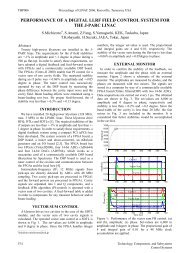Design and Development of a Diagnostics Client for a Beam Loss ...
Design and Development of a Diagnostics Client for a Beam Loss ...
Design and Development of a Diagnostics Client for a Beam Loss ...
You also want an ePaper? Increase the reach of your titles
YUMPU automatically turns print PDFs into web optimized ePapers that Google loves.
<strong>Design</strong> <strong>and</strong> <strong>Development</strong> <strong>of</strong> a <strong>Diagnostics</strong> <strong>Client</strong> <strong>for</strong> a <strong>Beam</strong> <strong>Loss</strong> Measurement System at CERN<br />
system will be made with the use <strong>of</strong> optical fibres.<br />
Regarding the processing part, it will combine the in<strong>for</strong>mation gathered by each channel<br />
<strong>and</strong> keep several moving integration windows between 2 μs <strong>and</strong> 1.2 s. The calculated<br />
values <strong>for</strong> each channel will be checked continuously against predefined threshold values<br />
both at the hardware <strong>and</strong> s<strong>of</strong>tware level, as well as being <strong>for</strong>warded to the control centre<br />
<strong>and</strong> databases <strong>for</strong> online observation <strong>and</strong> later analysis. The final system implementation<br />
will make use <strong>of</strong> a FESA server [20] running on a Linux CPU, which will provide data to<br />
clients to deal with settings <strong>and</strong> interlocks. The new BLM system, through its direct con-<br />
nection to the beam interlock system, will have the ability to block all upcoming injections,<br />
when the machine protection thresholds get exceeded [19].<br />
3.2 Acquisition Electronics <strong>of</strong> the BLM System<br />
The acquisition electronics refer to the part <strong>of</strong> the system, which contains the digitizer<br />
modules, the control unit <strong>and</strong> the crate that provides the hosting <strong>and</strong> interconnections.<br />
3.2.1 <strong>Beam</strong> <strong>Loss</strong> Electronic Acquisition Crate (BLEAC)<br />
The <strong>Beam</strong> <strong>Loss</strong> Electronic Acquisition Crate is the Electronic Crate, which hosts the<br />
BLEDP acquisition modules. Its design philosophy is to give the same attention to the<br />
measurement per<strong>for</strong>mance as well as the reliability <strong>of</strong> the entire system. The summary <strong>of</strong><br />
the design philosophy <strong>of</strong> the crate is explained through the following points:<br />
• Per<strong>for</strong>mance improving with respect to previous systems.<br />
• Increase the <strong>Beam</strong> <strong>Loss</strong> Measurement system reliability.<br />
• Preference to simple architectures.<br />
• Implementation <strong>of</strong> the design architecture independent from the component manu-<br />
facturers.<br />
• Implementation <strong>of</strong> protection <strong>and</strong> current limiting.<br />
• Guarantee a total separation between System Functionality <strong>and</strong> System Safety Func-<br />
tions.<br />
• Allowance <strong>of</strong> remote diagnosis.<br />
• Implementation <strong>of</strong> the full remote control <strong>and</strong> calibration. [14]<br />
The crate is based on a custom designed backplane which provides connection <strong>for</strong> 64<br />
channels (8x8) <strong>and</strong> <strong>for</strong> the BLEDP acquisition module, the connection with the power<br />
supply, voltages <strong>and</strong> control signals. In addition, the backplane has support <strong>for</strong> direct<br />
injection <strong>of</strong> a remotely adjustable reference current with two ways: (i) via a dedicated<br />
input or (ii) via an internal current source. For that purpose, each channel’s input goes<br />
through a relay contact. As a result, the system will be able to guarantee the full dynamic<br />
Emmanouil I. Angelogiannopoulos 17















